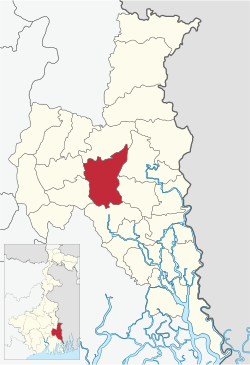Population
As per 2011 Census of India Deganga CD Block had a total population of 319,213, of which 309,550 were rural and 9,663 were urban. There were 163,154 (51%) males and 156,059 (49%) females. Population below 6 years was 39,415. Scheduled Castes numbered 39,027 (12.23%) and Scheduled Tribes numbered 2,560 (0.80%). [14]
Deganga (village) had a population of 3,377 as per 2011 census. [14]
In the 2001 census, Deganaga community development block had a population of 276,049 out of which 141,545 were males and 134,504 were females. [15]
There is only one census town in Deganga CD Block (2011 census figure in brackets): Deulia (9,633). [14]
Large villages in Deganga CD Block (2011 census figures in brackets): Fazilpur (4,084), Sohai (4,858), Biswanathpur (4,585), Kaliani (5,525), Chyandana (7,188), Khejurdanga (4,370), Belgachhia (4,026), Subrnapur (6,380), Parpatna (6,558), Uttar Kalsur (9,051), Dakshin Kalsur (6,731), Basudebpur (4,580), Matikumra (4,651), Amulia (4,443), Alipur (7,801), Kaukepara (8,707), Nandipara Kuchemora (4,936), Jadabpur (6,390), Chandpur (8,780), Keadanga (4,682), Hadipur Churijhara (9,971), Jhikra (4,315) and Abjan Nagar (5,544). [14]
North 24 Parganas district is densely populated, mainly because of the influx of refugees from East Pakistan (later Bangladesh). With a density of population of 2,182 per km2 in 1971, it was 3rd in terms of density per km2 in West Bengal after Kolkata and Howrah, and 20th in India. [16] According to the District Human Development Report: North 24 Parganas, "High density is also explained partly by the rapid growth of urbanization in the district. In 1991, the percentage of urban population in the district has been 51.23." [17]
Decadal Population Growth Rate (%)
The decadal growth of population in Deganga CD Block in 2001–2011 was 15.93%. [18] The decadal growth of population in Deganga CD Block in 1991–2001 was 18.10%. [19]
The decadal growth rate of population in North 24 Parganas district was as follows: 47.9% in 1951–61, 34.5% in 1961–71, 31.4% in 1971–81, 31.7% in 1981–91, 22.7% in 1991–2001 and 12.0% in 2001–11. [20] The decadal growth rate for West Bengal in 2001–11 was 13.93%. [21] The decadal growth rate for West Bengal was 17.84% in 1991–2001, 24.73% in 1981–1991 and 23.17% in 1971–1981. [22]
Only a small portion of the border with Bangladesh has been fenced and it is popularly referred to as a porous border. It is freely used by Bangladeshi infiltrators, terrorists, smugglers, criminals. et al. [23] [24] [25] [26]



